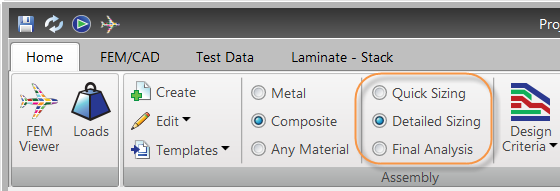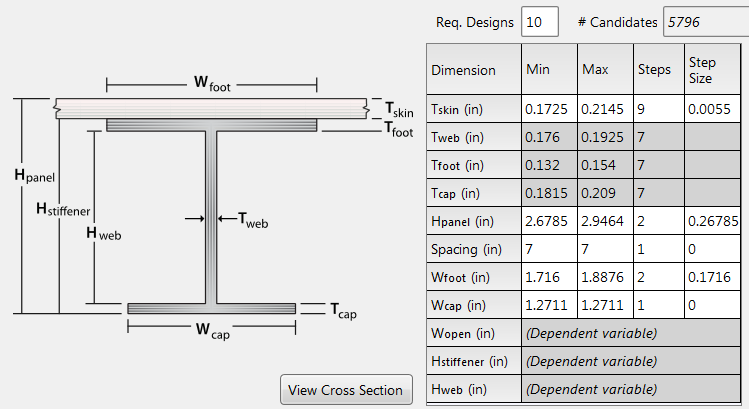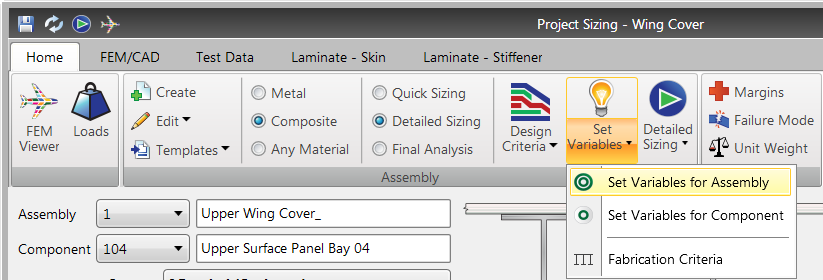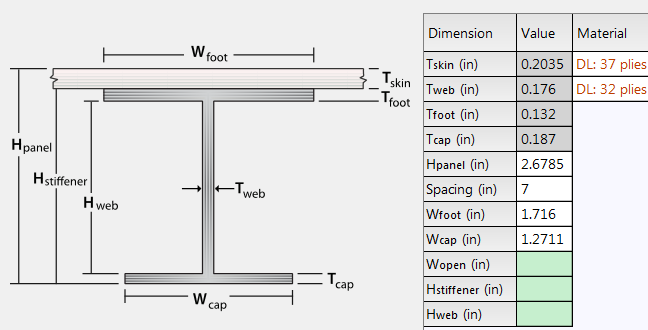
For each assembly, the analysis/sizing mode must be defined before selecting panel concepts.

To run rapid sizing, the material system must be defined for skin and stiffener. For composite panels the ply material is defined (Tape and/or Fabric). For metallic panels the isotropic material is selected for the skin and stiffener web.

Rapid sizing will return the optimum dimensions and ply counts for each component. The rapid sizing approach uses cross-section ratios and fabrication rules to size the panel cross section. The cross section ratios and fabrication rules are defined on the Fabrication Criteria Form. The Ply Angle Rules must be satisfied during rapid sizing. Rapid sizing uses these specifications to guide a non-parametric optimization of the stiffened panel without requiring the user to explicitly define parameter values. See Optimization Methodology.
Important: In V7.0, the rapid sizing method supports composite or metallic I & T stiffened cross sections.
Detailed sizing uses the local sizing optimization approach to size the cross section. See Optimization Methodology.
The local sizing optimization creates the full design space based on user-defined minimum and maximum variable bounds. Using the sizing form, it is easy to set variable bounds for cross-sectional dimensions and to provide a list of candidate materials and laminates to be selected. Some variables can be set, while others vary within minimum and maximum limits. The number of candidates are defined as the full factorial combination of the min and max bounds and available materials for each variable.

Whenever an analysis or optimization is performed, the same failure mode analyses and load cases are processed. For analysis, the margin of safety (MS) is reported for each potential failure mode. For optimization, the objective is to find a combination of materials and design dimensions that produce multiple margins of safety for all load cases and failure modes, such as strength and stability, stiffness requirements, and deformation limits.
Use the Set Variables option to automatically populate the minimum and maximum bounds for detailed sizing.

Important: In HyperSizer V7.0, the Set Variables method supports composite or metallic I & T stiffened cross sections.
Set Variables runs the rapid sizing algorithm to determine optimum dimensions and ply counts for each panel object. Discrete laminates are created based on the optimum ply counts. The discrete laminates must satisfy the Layup Rules defined for the assembly.
Set Variables will extrapolate the optimum dimensions based on the selections on the "Set Variables" form.

Based on the selections displayed above, the max Height dimension will be defined as 1.1*(Height determined by rapid sizing).
Final analysis mode requires only 1 dimension be defined per variable.

When an assembly is in final analysis mode no sizing is performed. A single cross section will be analyzed and margins of safety and controlling analysis data are returned.
